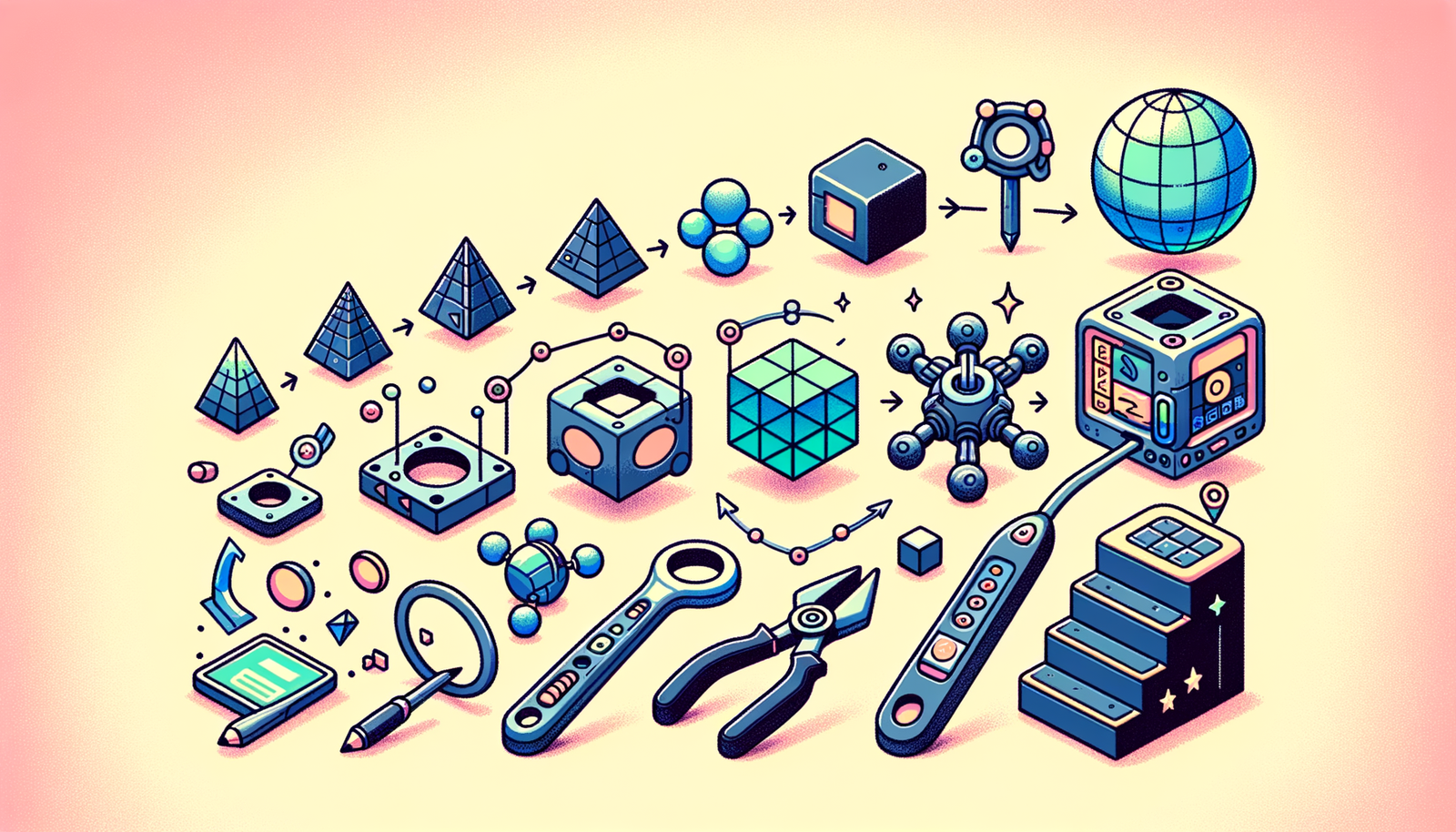Your Cart is Empty
Customer Testimonials
-
"Great customer service. The folks at Novedge were super helpful in navigating a somewhat complicated order including software upgrades and serial numbers in various stages of inactivity. They were friendly and helpful throughout the process.."
Ruben Ruckmark
"Quick & very helpful. We have been using Novedge for years and are very happy with their quick service when we need to make a purchase and excellent support resolving any issues."
Will Woodson
"Scott is the best. He reminds me about subscriptions dates, guides me in the correct direction for updates. He always responds promptly to me. He is literally the reason I continue to work with Novedge and will do so in the future."
Edward Mchugh
"Calvin Lok is “the man”. After my purchase of Sketchup 2021, he called me and provided step-by-step instructions to ease me through difficulties I was having with the setup of my new software."
Mike Borzage
Design Software History: Evolution of Geometric Modeling in Design Software: From Early Theories to Future Innovations
September 19, 2024 5 min read


Introduction to Geometric Modeling in Design Software
Throughout the history of design software, geometric modeling has played a pivotal role in transforming how designers conceptualize, develop, and realize their ideas. From the early rudiments of drawing on paper to the sophisticated computer-aided design (CAD) systems of today, geometric modeling is at the heart of this evolution.
Geometric modeling involves the mathematical representation of objects' shapes. This technique is crucial in various industries, such as automotive, aerospace, and architecture, enabling the precise creation and manipulation of complex forms. Its importance lies not only in the visualization but also in the simulation and optimization of designs, leading to more efficient and innovative products.
Early Mathematical Models and Theories
Foundational Theories and Concepts
The roots of geometric modeling can be traced back to the foundational mathematical models and theories developed centuries ago. Among these, René Descartes' introduction of the coordinate system in the 17th century stands out as a significant milestone. This system allowed for the representation of geometric shapes using algebraic equations, setting the stage for further advancements in geometric modeling.
In the mid-20th century, the field of computer science began to converge with mathematics, leading to revolutionary developments in design software. Early explorations into computer graphics and geometric modeling were driven by the need to visualize and manipulate data in more intuitive and flexible ways.
Pioneering Mathematicians and Computer Scientists
Several pioneering figures were instrumental in shaping the course of geometric modeling.
- Ivan Sutherland - Often referred to as the "father of computer graphics," Sutherland developed Sketchpad in 1963. Sketchpad was a groundbreaking interactive computer graphics system that allowed users to create and manipulate graphical objects directly on a computer screen. This innovation laid the foundation for modern CAD systems.
- Pierre Bézier - A French engineer working at Renault, Bézier introduced the Bézier curve in the 1960s. Bézier curves provided a mathematical method to represent smooth curves that could be easily controlled using a few points. This innovation was particularly valuable in automotive design, where smooth, aerodynamic shapes are crucial.
- James Ferguson - Ferguson developed the Ferguson curve, another mathematical representation of curves that offered greater flexibility and control compared to earlier methods. These curves became fundamental in geometric modeling, particularly in industries requiring precise and complex shapes.
Key Developments and Technological Advancements
Major Innovations in Geometric Modeling
The evolution of geometric modeling witnessed significant innovations that enhanced its capabilities and applications. Two notable advancements were the introduction of B-splines and NURBS (Non-Uniform Rational B-Splines).
B-splines, or basis splines, provided a flexible and efficient way to represent curves and surfaces. Developed in the 1960s, B-splines offered greater control over the shape of curves, making them ideal for complex design tasks. NURBS further extended the capabilities of B-splines by allowing for the representation of both standard analytical shapes (like circles and ellipses) and freeform shapes.
Another major development was the advent of solid modeling and boundary representation (B-rep). Solid modeling techniques enabled the creation of three-dimensional objects that could be manipulated and analyzed rigorously. B-rep, in particular, allowed for the precise definition of an object's boundaries, facilitating tasks such as collision detection, finite element analysis, and physical simulations.
Significant Software and Tools
The evolution of geometric modeling was significantly influenced by the development of powerful CAD software. These tools transformed how designers approached their work, offering unprecedented precision, flexibility, and efficiency.
- AutoCAD - Developed by Autodesk in the early 1980s, AutoCAD quickly became one of the most widely used CAD programs. Its user-friendly interface and robust feature set made it accessible to both novice and experienced designers.
- CATIA - Created by Dassault Systèmes, CATIA emerged as a leading CAD software in the aerospace and automotive industries. It offered advanced capabilities for 3D modeling, simulation, and analysis, making it an essential tool for complex design projects.
- SolidWorks - Acquired by Dassault Systèmes in the late 1990s, SolidWorks became a popular choice for mechanical design and engineering. Its parametric modeling approach allowed designers to easily create and modify parts and assemblies, streamlining the design process.
Companies like Autodesk, Dassault Systèmes, and PTC played pivotal roles in shaping the CAD industry. Their contributions extended beyond software development to include innovations in user interfaces, collaboration tools, and cloud-based solutions, further advancing the capabilities and accessibility of geometric modeling.
Current Trends and Future Prospects
Modern Applications and Use Cases
Today, geometric modeling is an integral part of various advanced applications, pushing the boundaries of what is possible in design and manufacturing. One of the most notable applications is in the realm of additive manufacturing, commonly known as 3D printing.
3D printing leverages geometric modeling to create intricate, customized objects layer by layer. This technology has found applications in industries ranging from healthcare, where it is used to produce patient-specific implants, to aerospace, where it enables the production of lightweight yet strong components.
Geometric modeling is also crucial in complex simulations and visualizations for product development. Engineers and designers use sophisticated software to simulate how products will perform under various conditions, enabling them to optimize designs before physical prototypes are created. This approach saves time and reduces costs while improving product performance and reliability.
Future Directions and Emerging Technologies
The future of geometric modeling is poised to be shaped by several emerging technologies and trends. One of the most promising directions is the integration of artificial intelligence (AI) and machine learning.
AI can enhance geometric modeling by automating repetitive tasks, optimizing designs based on predefined criteria, and even generating new design concepts. Machine learning algorithms can analyze vast amounts of data to identify patterns and make predictions, further improving the efficiency and effectiveness of the design process.
Another exciting prospect is the development of real-time rendering and virtual reality (VR) technologies. These advancements allow designers to immerse themselves in their creations, providing a more intuitive and immersive experience. Real-time rendering enables instant visualization of changes, facilitating quicker iterations and decision-making. VR, on the other hand, offers a sense of scale and presence that is difficult to achieve with traditional screen-based tools.
Conclusion
Reflecting on the history of geometric modeling in design software, it is evident that this field has undergone remarkable transformations. From the early mathematical models and theories to the sophisticated tools and techniques of today, geometric modeling has continually pushed the boundaries of what is possible in design and engineering.
As we look to the future, the continued innovation and integration of emerging technologies promise to further revolutionize geometric modeling. The potential for AI, machine learning, real-time rendering, and VR to enhance the design process is immense, offering new possibilities for creativity, efficiency, and precision.
Ultimately, the journey of geometric modeling is a testament to the power of human ingenuity and the relentless pursuit of excellence in design. As we continue to explore new horizons, the impact of geometric modeling on various industries and our daily lives will undoubtedly grow, shaping a future where design knows no bounds.
Also in Design News

Revit Tip: Precise Property Boundaries and Site Component Placement in Revit
December 24, 2025 2 min read
Read MoreSubscribe
Sign up to get the latest on sales, new releases and more …




